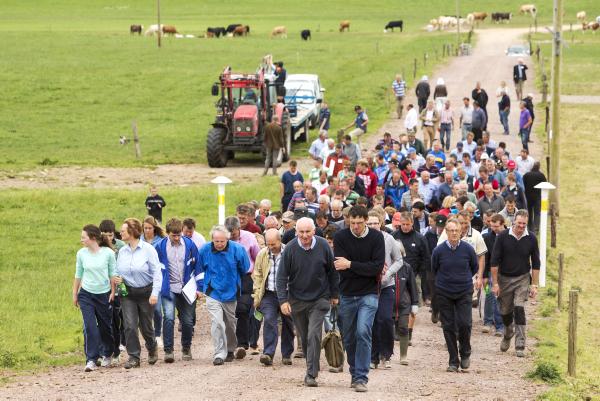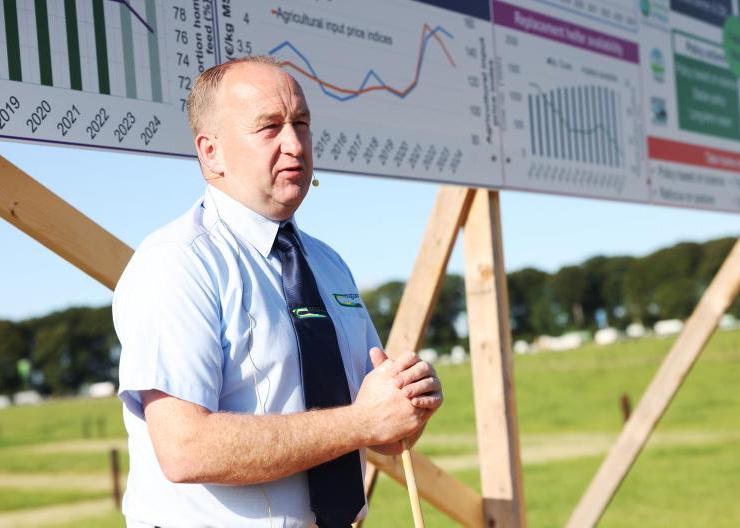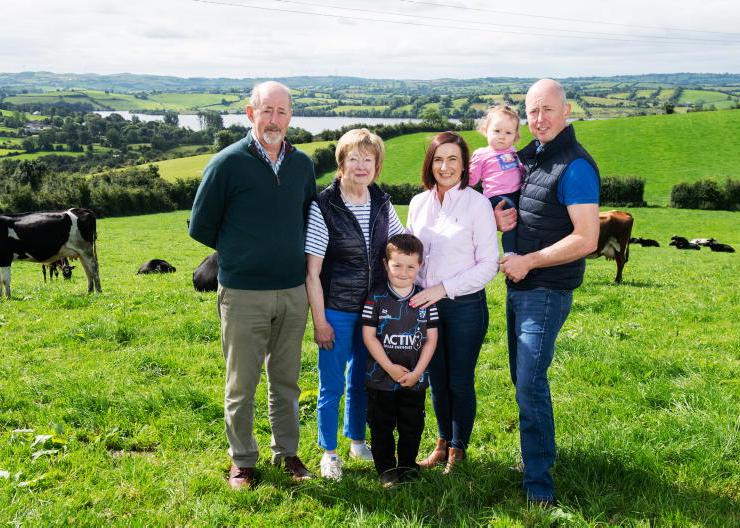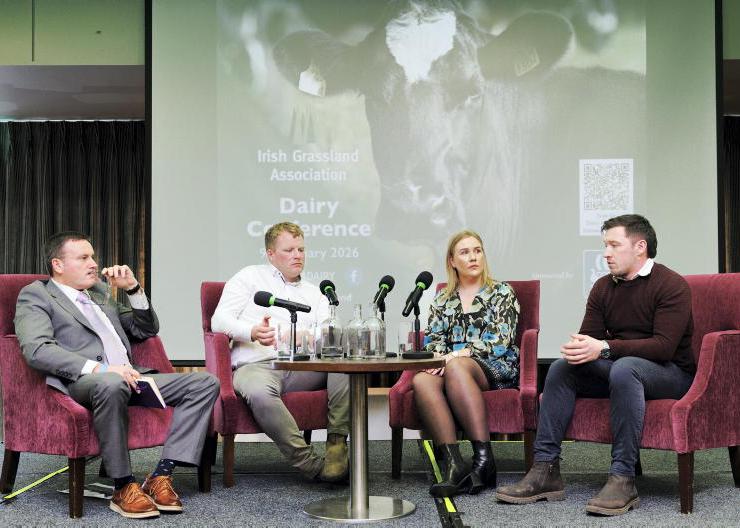Making Suckling Work for You, the Right Cow and the Right Grass was the title for this year’s Irish Grassland Association (IGA) summer tour, which was held on Tuesday.
The tour started in Mooncoin, Co Kilkenny, on the 53ha farm of James and Mary Grace, where grass is growing at a rate of 12t DM/ha/year. As James welcomed the group to the farm, he said: “I set out a couple of years ago to try and get as much as I can out of grass and that is the whole ethos of the farm.”
According to Teagasc adviser Austin Flavin, the national average grass production is in the region of 7t DM/ha. If James was growing 7t DM/ha, he would be able to carry just 37 suckler cows with their calves and 30 store to forward store cattle per year.
If he was producing 10t DM/ha, he could carry 52 cows with 30 store cattle. Producing 12t DM/ha, he could carry 63 cows and 30 stores.
James is currently carrying 59 autumn-calving cows and buys 30 dairy calves each year, which are brought to beef. It was calculated that the difference between growing 12t DM/ha compared to the national average of 7t DM/ha is worth an additional €13,000 to the farm on an annual basis. Austin said this can only be achieved through good grass measuring, a reseeding programme and good soil fertility.
Grow your grass in three weeks and graze your grass in three days, was the message. James has seven grazing groups on the farm. Each group is grazed on a block of paddocks which are treated as a separate farm. There are 43 paddocks in total. These paddocks range in size with the aim being to keep quality, leafy pasture in front of the animals as often as possible.
James spends an hour and a half on a Sunday mornings measuring paddocks.
“It’s just a matter of getting used to it,” he said.
He feeds about 12 tonnes of meal per year. At maximum capacity, there could be 190-200 cattle on the farm.
According to Austin, it is because grass is managed so well that the feed bill is kept so low.
The tour was then taken across the River Suir to the farm of Tom and Bridget Murphy, near Portlaw, Co Waterford. The 150-cow suckler herd, with all offspring finished to beef, is carried on the 92ha farm, which is in three blocks. The herd is split 50% autumn- and 50% spring-calving. Heifers are finished at 18-20 months at 380kg, and the bulls are finished at 16-18 months at 420kg. Grassland management is key on this farm too.
According to Adam Woods of Teagasc: “We need to step back from set stocking – the first step is paddocks and drinkers.”
This year, Tom Murphy installed an additional 12 drinking troughs as this allows him to split his paddocks more effectively in order to optimise grass utilisation. He also plans to invest in additional permanent fencing. These investments are to ensure that the Murphys maximise liveweight gains from grass.
Teagasc’s Karen Dukelow advised that farmers should be looking at having six to seven paddocks per grazing group. She said that this leaves more flexibility to keep fresh grass in front of stock and to take paddocks out if needs be. If you only have three paddocks, you will have to spend more than three days grazing the same paddock.
Tom also helps out with grassland management on his brother’s dairy farm, and he says grassland management on the cattle side is more challenging than for dairy systems, as more grazing groups mean that grass surpluses or shortages can be more difficult to identify.
The point was made that dairy farmers have the figure of litres per cow, in tillage you have tonnes/ha and for beef you need to keep an eye on the value for kg of beef output per ha. This will give an indication of efficiency for the farm.
The Murphys are producing 896kg/ha compared to a national average 627kg/ha.
Making Suckling Work for You, the Right Cow and the Right Grass was the title for this year’s Irish Grassland Association (IGA) summer tour, which was held on Tuesday.
The tour started in Mooncoin, Co Kilkenny, on the 53ha farm of James and Mary Grace, where grass is growing at a rate of 12t DM/ha/year. As James welcomed the group to the farm, he said: “I set out a couple of years ago to try and get as much as I can out of grass and that is the whole ethos of the farm.”
According to Teagasc adviser Austin Flavin, the national average grass production is in the region of 7t DM/ha. If James was growing 7t DM/ha, he would be able to carry just 37 suckler cows with their calves and 30 store to forward store cattle per year.
If he was producing 10t DM/ha, he could carry 52 cows with 30 store cattle. Producing 12t DM/ha, he could carry 63 cows and 30 stores.
James is currently carrying 59 autumn-calving cows and buys 30 dairy calves each year, which are brought to beef. It was calculated that the difference between growing 12t DM/ha compared to the national average of 7t DM/ha is worth an additional €13,000 to the farm on an annual basis. Austin said this can only be achieved through good grass measuring, a reseeding programme and good soil fertility.
Grow your grass in three weeks and graze your grass in three days, was the message. James has seven grazing groups on the farm. Each group is grazed on a block of paddocks which are treated as a separate farm. There are 43 paddocks in total. These paddocks range in size with the aim being to keep quality, leafy pasture in front of the animals as often as possible.
James spends an hour and a half on a Sunday mornings measuring paddocks.
“It’s just a matter of getting used to it,” he said.
He feeds about 12 tonnes of meal per year. At maximum capacity, there could be 190-200 cattle on the farm.
According to Austin, it is because grass is managed so well that the feed bill is kept so low.
The tour was then taken across the River Suir to the farm of Tom and Bridget Murphy, near Portlaw, Co Waterford. The 150-cow suckler herd, with all offspring finished to beef, is carried on the 92ha farm, which is in three blocks. The herd is split 50% autumn- and 50% spring-calving. Heifers are finished at 18-20 months at 380kg, and the bulls are finished at 16-18 months at 420kg. Grassland management is key on this farm too.
According to Adam Woods of Teagasc: “We need to step back from set stocking – the first step is paddocks and drinkers.”
This year, Tom Murphy installed an additional 12 drinking troughs as this allows him to split his paddocks more effectively in order to optimise grass utilisation. He also plans to invest in additional permanent fencing. These investments are to ensure that the Murphys maximise liveweight gains from grass.
Teagasc’s Karen Dukelow advised that farmers should be looking at having six to seven paddocks per grazing group. She said that this leaves more flexibility to keep fresh grass in front of stock and to take paddocks out if needs be. If you only have three paddocks, you will have to spend more than three days grazing the same paddock.
Tom also helps out with grassland management on his brother’s dairy farm, and he says grassland management on the cattle side is more challenging than for dairy systems, as more grazing groups mean that grass surpluses or shortages can be more difficult to identify.
The point was made that dairy farmers have the figure of litres per cow, in tillage you have tonnes/ha and for beef you need to keep an eye on the value for kg of beef output per ha. This will give an indication of efficiency for the farm.
The Murphys are producing 896kg/ha compared to a national average 627kg/ha.













SHARING OPTIONS